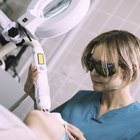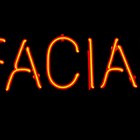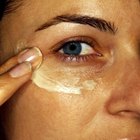Laser skin rejuvenation, which goes by many different names, such as laser resurfacing, photofacials, laser skin therapy and photorejuvenation, is an effective non-surgical cosmetic procedure. Increasingly popular as an anti-aging solution, laser rejuvenation aims to correct various skin conditions and restore youthfulness to the skin with laser technology. It can correct discoloration caused by sun damage, fine lines and wrinkles, scars, unwanted birthmarks, broken capillaries, redness caused by Rosacea, among other tratable skin conditions. Laser resurfacing is a safer and less costly alternative to cosmetic surgery, though the cost of laser treatment varies greatly.
Ablative Versus Non-Ablative
There is some confusion when researching laser rejuvenation costs, most of which stems from the wide gap in prices. One source lists $150 treatments, while another says laser rejuvenation is upwards of $1,500. This is mainly due to the difference in laser types, which fall under two categories: ablative and non-ablative. Ablative lasers work by approaching the entire surface layer of the skin and vaporizing it to remove skin irregularities, like age spots and wrinkles. The non-ablative lasers, which are the more recent development in laser technology, actually penetrate the skin and work beneath its surface to not only correct skin irregularities but stimulate collagen production and new cell turnover. Non-ablative lasers are said to cause "controlled injury" in the skin in order to repair it.
Selection
Ablative and non-ablative lasers each have pros and cons, and within those two categories of laser types, the choices become even more specific, as there are multiple types of ablative and non-ablative lasers that serve different purposes and offer various benefits. The non-ablative lasers can target and correct specific skin conditions of severe depth with a much shorter recovery time than ablative lasers offer, since they burn the skin's surface. Non-ablatives also use computer technology to control laser light color to optimize treatment of sun spots, scars, skin redness, birthmarks and other discoloration issues. Ablative lasers can also make these corrections, but are more often used to correct wrinkles, and in one treatment, restore the overall look of the entire face.
Average National Cost
According to the American Society for Aesthetic Plastic Surgery, as of 2009, the average cost for non-ablative laser rejuvenation is $845 per treatment. The average cost for ablative laser rejuvenation treatment is $2,341. This seems like quite a difference for two laser types that promise to yield the same results. A key fact to consider is that non-ablative skin rejuvenation is likely to require multiple treatments to obtain the desired results, while ablative laser rejuvenation promises to achieve the desired results with one treatment. From this perspective, the costs don't differ as much.
Cost Variables
Within the ablative and non-ablative categories, the cost of laser skin rejuvenation still varies. There are a number of variables that influence cost, including the skin condition of the patient and desired results, as well as the geographic region in which the procedure is performed. The skill and experience of the surgeon or dermatologist who performs the procedure also plays a role in the cost. The type of laser used within the ablative and non-ablative categories influences the cost as well.
Laser Types
Ablative lasers most commonly used for laser skin rejuvenation include the CO2 laser and the erbium. The CO2 is the strongest, highest intensity laser treatment available (as of 2009). The CO2 treatment yields tighter, smoother skin, because of its heat effect on collagen bands in the lower layers of the skin tissue, in additioon to correcting texture and color conditions. The CO2 is also used to treat cancer in its early stages. The erbium laser, not as strong as the CO2, can remove thinner skin layers, which is preferable to patients with darker skin who don't want to risk pigmentation side effects.
Non-ablative laser types include the fractional or fractionated lasers, like the Fraxel laser, which targets small areas of skin with precision. These lasers leave the surrounding tissue undamaged. The Intense Pulsed Light laser is widely used for skin rejuvenation, as well. By scientific definition, the IPL is not technically a laser. It uses pulsed light to absorb into the skin and dissolve unwanted cells that cause irregular pigmentation. This laser is optimal for correcting sun damage discoloration, minimizing the pores, and stimulating collagen production, which thereby reduces and prevents wrinkles.
Cost Considerations
The least costly treatment available might not work for your skin type or skin condition, so it is not wise to make a laser type choice based solely on cost. Rely on the doctor to tell you which type of laser rejuvenation treatment is best. Consider costs from this step forward.
Warning
As of 2009, state and national medical boards are still pushing for regulation on the administration of laser treatment, since non-medical practitioners, such as aestheticians, are beginning to offer laser treatment without the medical and specialized training, which medical boards feel should be required. Because laser rejuvenation involves highly advanced medical and scientific technology and requires extreme precision, it is safest for patients to seek treatment from a plastic surgeon. Costs that seem to good to be true probably are, and patients should be cautious about who they choose to perform laser treatment, since there could be risks and complications that result from an unskilled provider.
Related Articles

What Are the Dangers of Fraxel Repair?

Fraxel Repair Vs. Restore Results

Home Remedies to Permanently Remove ...

Laser Treatment for Face Wrinkles

Photofacial Vs. Microdermabrasion

Does Microdermabrasion Work to Remove ...

Homeopathy Cure for Stretch Marks

Microdermabrasion for the Neck

Do Peels Work for Stretch Marks?

Long-Term Health Risks of Laser Hair ...

Costs for Ideal Image Treatments

What Is Skin Polishing?

What Are the Dangers of Photofacials?

The Best Facial Moisturizers for People ...

How to Remove Dark Marks From Skin

Removing Acne Scars With Tretinoin Cream

Collagen & Rosacea

How to Remove an Eyebrow Tattoo

Fraxel Laser Treatment Dangers

Teens & Cellulite
References
Writer Bio
Isobel Washington has been a freelance journalist since 2007. Washington's work first surfaced in Europe, where she served as a restaurant critic and journalist for "LifeStyles" magazine. Her love of travel and culture inspired her first novel, which is currently underway. Washington has a 10-year career in marketing communication and holds a Bachelor of Science degree.